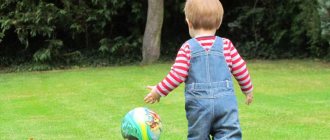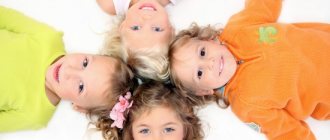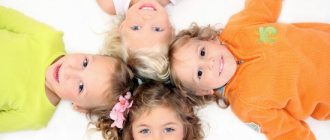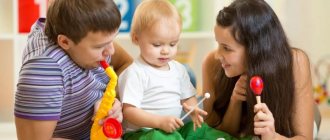“...in a community, under guidance, with help, a child can always do more and solve the most difficult problems than on his own.” A.V. Zaporozhets, famous Russian psychologist.
I want to draw the attention of parents to a very important period of the baby’s development, which we call “pre-speech”. It is during this period that the baby prepares for further speech development, which is not yet noticeable, but is already very actively happening. From my many years of experience, I know that many mothers pay little attention to the baby’s humming and babbling; many do not even know what it is and how they differ.
But the first symptoms of trouble can manifest themselves precisely during this period, when the child’s nervous system is still very plastic and susceptible to therapeutic influence. You should also not make preliminary diagnoses, because we are adults too, very different. Some are talkative, some are called “silent”, one cannot live without communication, while the other likes to be alone. And our children are like us, of course. Along with the norm, I give examples that, in combination with other symptoms, should alert parents.
Often there is nothing serious behind these symptoms, just a minor correction is needed. Mothers come to see me with completely healthy children who had babbling and humming features. Yes, not everyone who had deviations in pre-speech development later developed problems with speech and reading; very often everything returned to normal. But all children with speech difficulties necessarily had disorders of early speech and pre-speech development.
Stages of pre-speech development
- The first year of life is called the period of pre-speech development, during which preparation for mastering speech occurs. From the very first day of life, the child prepares for speech. Already from the moment of birth there are vocal reactions - screaming and crying. With these signals, the baby communicates that he feels bad, is hungry, and is sick. A healthy newborn makes individual sounds between “a” and “e”.
- You should pay attention if the baby sobs when sighing, with a characteristic nasal tint, or if there is a piercing, painful, continuous cry, which is usually called “brain”. If these symptoms do not go away, you should consult a specialist.
- Gradually, the child learns to listen to his own speech and the speech of others. From the 1st month, the baby calms down when he hears a lullaby. Increased interest in human speech in the form of a concentration reaction appears at 4 - 5 weeks. When an adult leans over a child and talks to him tenderly, he stops crying and moving and “listens.” At 5-8 weeks, the child smiles in response to the speech of an adult, from 8 weeks - a real smile, by 9-12 weeks laughter appears. Starting from 6-8 weeks, in response to an adult’s attempt to make contact, the baby makes individual sounds - hooting (initial humming). True humming or melodious humming appears in the 2-3rd month. The child, being in a calm state, makes drawn-out vowel sounds.
- With certain pathologies of the nervous system, a child may not show interest in an adult’s speech and may not respond to surrounding objects. In children in such cases, negative reactions usually predominate (monotonous crying, prolonged screaming in one tone), smiling is extremely rare, and there is no humming.
- By 5-6 months, the nature of the sounds becomes more complex. Combinations appear: “baaa, maaa”, “taaa, paaa”. Observing a child, one can note that at the moment of pronouncing sounds, he slows down his vocal movements, as if listening and imitating himself, pronounces sounds in the form of chains. By about the 5th month of life, sound and syllable pronunciation begin to acquire some semblance of words. By 5-6 months, the humming gradually turns into clear and distinct speech sounds, and babbling speech appears. The first babble consists of short chains of syllables: ba-ba-ba, ma-ma-ma. Parents sometimes mistake such babbling strings for meaningful speech, but these, of course, are not words yet.
- Children with a lack of humming, low expressiveness of speech, and lack of imitation deserve special observation. A child with initial signs of early childhood autism may be clearly non-communicative, passive, indicative reactions will be reduced or, conversely, motor activity, anxiety, negative emotional reactions to new objects (crying, screaming) will predominate.
- By 9 months, babbling is enriched with new sounds, intonations, and develops into long rows of syllables. Babbling becomes a constant response to an adult’s voice and accompanies various actions with objects and toys. At 9 months, the child demonstrates understanding of speech addressed to him, reacts to his name, perceives some simple verbal instructions and responds to them with action: “open your mouth”, “give me a pen”, presses his cheek to his mother when asked “kiss mom”, raises his head and their eyes turn to the lamp when asked “where is the light?”, they look for a toy hidden in front of their eyes, when they hear the word “no” they stop reaching for any object, or stop pulling it into their mouth, etc. Children aged 9-10 months are characterized by active babbling, consisting of 4 - 5 syllables or more. The child repeats new syllables after the adult, which he himself has not previously uttered, and copies intonation well, accompanying it with expressive facial expressions and gestures. By 9-10 months, he pronounces individual words consisting of identical paired syllables (mom, dad).
- A child of 11-12 months increasingly pays attention to the face of the speaker, begins to nod his head as a sign of approval and shake it as a sign of denial. The syllables included in babbling become components of words: ma-ma-ma - “mother”. The baby begins to designate certain objects with sound combinations, for example: car - “beep”, etc. At the same time, children of this age usually develop a new interest - looking at books with pictures. Recognizing familiar objects in pictures or showing them at the request of an adult, children designate them with babbling words.
- By the age of one year, the dictionary usually reaches 8-10, and sometimes more, “words” (baba, kisa, mu, be, etc.) that have a specific meaning. By the age of 1, the child understands and follows 5-10 simple instructions: “bring this,” “close the door,” “give me a cup,” etc. Thus, in the first year of life, the child’s speech apparatus is preparing to pronounce sounds. At the same time, there is an active process of developing speech understanding.
Speech development of a child in the first year of life
The first sound a baby makes is its first cry at birth.
It is not yet related to speech, but it is already a reflex of the vocal apparatus. And every mother, in the first days of a baby’s life, listens with special tenderness and anxiety to how he smacks his lips, sighs, grunts, screams - sometimes demandingly, sometimes pitifully, every hour approaching the moment of the “greatest discovery.” Where does communication begin? It is known that in the first two to three weeks of life a child does not show any initiative towards an adult. But despite this, his parents constantly talk to him, caress him, and catch his eye. It is thanks to the love of adults, which is expressed in such simple actions, that at the end of the first month of life the child first begins to respond to them, and a little later he himself takes the initiative with the so-called revitalization complex. The baby looks the adult in the eyes, smiles, gurgles joyfully, waves his arms, arches his whole body, demonstrating satisfaction from his presence and attracting his attention.
From the first days, a loving mother peers into the baby’s face, trying to catch his gaze. It even seems to her that he recognizes her and rejoices at her appearance. The way it is. As soon as you think your baby is looking at you, smile at him. By doing this you will support his first initiatives in communication. By the end of the second week of life, the child can fix objects with his gaze, and a little later - trace their movement. At this age, he already knows his mother well - her voice, smell, sound of steps. From the very first days, the mother’s face and her eyes are a rich source of information and reinforcement of the baby’s first active attempts to establish a connection with the world.
From three to five to six weeks of age, such eye communication is especially important for the baby. He stubbornly, day after day, throughout his waking hours, tries to catch and hold his mother’s gaze. He doesn’t know how to smile yet, but in response to the mother’s affectionate conversation and smile, the muscles of his face relax, and the mother sees that the baby is enjoying communicating with her.
By one and a half months, eye contact becomes a strong, independent means of communication. After all, by this time he has a new tool, which the mother is already actively using, and the child is just mastering - a smile. A smile is an expression of joy and pleasure, a means of communication, a sure-fire way to attract the attention of an adult, keep him near you, force him to communicate and, of course, talk.
It has been proven that babies react differently to the voices of mom, dad, grandma, and strangers; in total, they distinguish up to thirty voice tones and intonations. By communicating with each other in a friendly, calm manner, you do not frighten the baby or create grounds for anxiety and fear. Rude conversations and showdowns in front of the baby disturb him internally, stress him out, hence the sleepless nights and crying for no apparent reason.
It is well known that crying is bad, it is a signal that diapers need to be changed, a pacifier should be given, etc. But crying is not only a signal of inconvenience and dissatisfaction, but also a call for communication; it is the very first language of a child, a form of manifestation of desire and understanding.
THE FIRST HALF YEAR of a child’s life is a stage of emotional and personal communication with people around him, which satisfies his need for attention, goodwill, and love. The attachment to an adult that a child develops in the first months makes him very receptive to communication. An adult, talking to a baby, caressing him, affects all senses: vision, hearing, smell, touch. A child, observing the actions of an adult, subsequently strives to imitate him. Thus, the emotional communication of a child with an adult, having a decisive influence on the formation of all aspects of the infant’s psyche, becomes the leading activity of the child in the first half of life.
Nothing can replace the warm, emotional interaction between an adult and a child. If a child is deprived of this, developmental delays and difficulties arise: he grows up sluggish, lacking initiative, his speech and cognitive activity lag behind the norm, and difficulties arise in communication. And only in personal communication does a child develop a feeling of being needed by another, which is so necessary for a feeling of security, increased vitality, and self-confidence.
Preparation for language acquisition begins as early as 2-4 months with exercises in pronunciation of individual sounds. In psychology, this stage is usually called the period of humming. The child pronounces velar and vowel sounds, somewhat reminiscent of the combinations “GHAIY”, “GHOIU” - hence the origin of the good tradition of “humming” with children.
The next stage in preparation for language acquisition is the period of babbling or syllable speech. It lasts until approximately the end of the child's first year of life and marks the beginning of language acquisition and understanding of individual words and sentences. As L.S. writes Vygotsky, the child begins to understand that sounds and their combinations can mean certain objects, that with their help you can achieve a lot, that by saying “am-am” you can get food, and by saying “mama” you can call your mother.
There is evidence that even before the appearance of their own speech, children already understand from 50 to 100 words. An observant mother may notice that at about 8 months the baby imitates the sounds he hears. The child calls the dog “av-av”, the cow “mu”, and a number of imitations of words spoken by adults appear.
The child speaks his first words at the end of the first year of life. As a rule, girls aged 11-12 months already have about ten words in their active vocabulary. Boys begin to speak their first words at 13-14 months; in speech development, girls are about 4-5 months ahead of boys. A particular period in the development of speech can occur at different times. The level of physical development of the child, the state of his nervous system, the influence of the language environment - all this either stimulates or inhibits the formation of his speech. Constant mastery of speech skills is reflected in the formation of the child’s thinking, as well as his personality and characterological characteristics.
It is advisable that every mother keep a diary and record not only significant dates in the child’s physical development, but also periods of the baby’s speech development. If parents are worried or alarmed by something, for example, there is a period of humming, the period of babbling is delayed, they should immediately contact a specialist: an otorhinolaryngologist, a pediatric neurologist - neonatologist, a pediatrician, a speech therapist.
Already at an early age it is necessary to pay attention to the development of auditory attention. Starting from 6-7 months, the child determines the direction of the sound - a bell, a pipe, a rattle. Having demonstrated how they sound, parents can invite the child to imitate knocking, either loudly or quietly. The baby is already ready to listen to music, and if you watch him carefully, you can determine which one he likes best. Already during the period of revelry, he becomes animated, begins to “sing along”, knocks with his arms and legs. Later, from 7-8 months, he dances, claps his hands, and “sings.” There are no children who remain indifferent to the sounds of music.
At the end of the first year of life, the child responds correctly to many words addressed to him. We say: “Show your nose!”, “Make some fun!”, “Where is mom?” - and he shows his nose, claps his hands, looks for his mother with his eyes. He is sensitive to intonation, responding adequately to questions and exclamations, to a stern tone and praise. In the first six months of life, the baby especially needs emotional communication with an adult, and it is not the content that is important, but a cheerful intonation, a smile - he perks up, and vocal reactions intensify. And after six months, emotionality in communication is no longer enough for the child. He must be taught to understand short, light words, no more than two syllables, ending with a vowel sound.
Onomatopoeic words are acceptable: “kisa”, “am-am”, “bobo”, “av-av”. Every mother, and all adults in the family, must monitor their speech, the correctness and clarity of pronunciation of sounds, the rhythm and tempo of speech, as they provide material for imitation. Adults caring for children should try to get rid of the shortcomings of their own speech. Don't talk to them continuously - it tires them out.
And one more condition: you need to talk with the child about what is in his circle of attention. During feeding, the mother can draw his attention to the cup, plate, spoon. You need to talk to children only about what they themselves see and what they are doing. Among other things, they need to create such conditions that they ask an adult for something, so that their desires are not warned before they have time to express them in word or gesture.
After six months, you can work on articulation, that is, speech motor skills. For example, a child smiles - the lip muscles are activated. The “horse” exercise is suitable for activating the tongue. The sooner you teach your baby to click his tongue, sucking his tongue to the roof of his mouth, the sooner sounds that require the upper elevation of the tongue (w, g, r, l, etc.) will appear in his speech.
By the end of the first six months of life, the child begins to become more and more interested in surrounding objects. Joint substantive actions come to the fore, and they become the child’s leading activity in the second half of life. Of course, the baby still needs attention and affectionate touches, but now they become just a background - the child wants to play and act with objects. Showing interest in surrounding objects, he tries to bite them and extract sounds from them. But often after 2-3 minutes the toy is thrown, and the baby calls his mother again. And again she asks for the same toy, trying to explain to her that they should explore the world together! Independently, one on one, a child can only know what is available - the physical properties of the world. Any toy is a very complex artificial model, which contains information about the properties of objects, a method of acting with them, and, what is very important, an attitude towards them. Only in joint activities with him can the child master all this. Of course, the baby should (and will!) play independently. But a toy is not a substitute for an adult. Find games that both your child and you would like, and learn to play with your baby, becoming involved in his life. For example, do finger gymnastics with your child.
Studies of the activity of the children's brain and the psyche of children indicate the great stimulating value of the hand function. The level of development of their speech is directly dependent on the degree of formation of fine movements of the fingers. From 6-7 months you can start training your fingers - massage your hands, each finger, each phalanx. Knead and stroke them for two to three minutes every day. And from the age of 10 months, active exercises for the fingers are also included: babies should roll small balls, play with cubes, pyramids, and learn to transfer small objects from one pile to another. Folk nursery rhymes provide good training for finger movements:
The white-sided magpie was cooking porridge. She fed the kids and gave it to this one. Gave to this, Gave to this, Gave to this, Gave to this...
In this case, the index finger of one hand makes circular movements along the palm of the other hand. Then the little finger, ring finger, middle finger, index finger and thumb are bent in turn. Another version of this nursery rhyme - the thumb doesn’t bend: ... But I didn’t give it to this one: You didn’t carry water, You didn’t chop wood, You didn’t cook porridge - You have nothing!
Children bend into a fist and straighten the fingers of their left and right hands alternately. Mom helps keep them from involuntary movements. You can also use the following poems: This finger is grandfather, This finger is grandmother, This finger is daddy, This finger is mommy, This finger is me. Or: This finger wants to sleep. This finger is a jump on the bed! This finger took a nap. This finger is already asleep. Fingers stood up. Hooray! It's time to go to kindergarten.
To train your fingers, you can use exercises without speech accompaniment. First, parents demonstrate all the exercises themselves. For example: “fingers say hello” - the tip of the thumb of the right hand alternately touches the tips of the index, middle, ring and little fingers. “The little man ran” - the index and middle fingers of the right hand “run” across the table.
“Baby Elephant” - the middle finger is put forward (trunk), and the index and ring fingers are the legs. The baby elephant “walks” along the table. If parents have a rich imagination, they will come up with and tell fairy tales, accompanying them with images of various figures made of fingers. Activities should bring joy to the child and be carried out easily, without unnecessary stress.
I would like to once again draw the attention of parents that the second half of life is the period when the child masters the world of objects and their properties. The child’s motor activity increases significantly: he crawls, demands toys, and tries to jump out of the playpen. Bruises and physical pain are not the most dangerous consequences of a new period of life in the second half of the baby’s first year. It is much worse if the baby’s activity causes rejection by an adult who is in a hurry to quickly complete the necessary care for the child and put him to bed. Very often the same events have different psychological value for an adult and a child. What seems trivial to an adult often turns out to be very important to a child. For example, in the bath, the baby became interested in the shiny taps, examines and studies them. The adult wants to finish the bath quickly and forcibly tears the child away from the taps, who screams in indignation. The child needs to understand that the examination, which is currently forming the psychological mechanisms of perception, creating individual attitudes towards overcoming obstacles and self-stimulation of cognitive activity, has been interrupted.
The development of a child’s intelligence, memory, and attention at this age largely depends on the variety of opportunities provided for his actions with objects, so artificially interrupting your baby’s spontaneous activity can inhibit his intellectual development.
Shevtsova E. E. Vorobyova V. E.
What should mom do?
By “infecting” the baby with positive emotions, the mother stimulates his interest in the outside world, and since the satisfaction of this interest involves the expenditure of physiological resources, she stimulates in a certain direction both metabolic processes and tissue differentiation in the body of her baby. On the contrary, by transmitting negative emotions to the baby, we suppress not only his interest in the outside world, but also certain biological processes of his body. It is no better when the adults around the child “infect” him with too strong affective emotions.
These energy-intensive emotions deplete the child’s nervous system and can lead to somatic diseases. An adult’s mechanical fulfillment of routine tasks, his indifferent, indifferent attitude towards a small child excludes the possibility of any kind of emotional contact at all. With such an adult, the child does not have the need to communicate, and therefore does not develop cognitive experience and does not form the necessary communicative-cognitive means. There is a threat of delayed mental development and disruption of the child’s further interaction with adults. The child’s brain develops incorrectly or is delayed in the absence or deficiency of external stimuli.
And, vice versa: interest in an adult, curiosity about the outside world and communicative-cognitive activity are caused and supported, as we have seen, by positive emotions emanating from an adult. Therefore, we can repeat once again that for infancy, the emotional communication of a child with an adult is not a luxury, but a primary necessity, a condition for the formation of his psyche according to the human social type. Depriving an infant of the emotional attention of an adult at this early age leads primarily to abnormal development of the child’s personality.
If parents notice trouble, and this is not one symptom, but several (lack of babbling, humming, change in voice, behavior), then you should contact a specialist. And then, along with speech therapy correction (massage, articulation gymnastics, stimulation of vocal reactions), drug treatment, physiotherapy, etc. are prescribed.
How to stimulate speech development
The sooner trouble is noticed in the development of a child’s speech and the sooner specialists begin working with him, the better the results achieved will be: the reserve capabilities of the brain are especially high at an early age, during the period when speech is actively developing.
At the stage of pre-speech development (1-3 months), it is necessary to stimulate motor and communicative functions, develop and consolidate the child’s need to communicate with adults, strengthen the ability to fix gaze and follow a moving object. Gradually move on to active stimulation of fine motor skills. If there is no humming or impaired vocal reactions at this stage, the doctor may prescribe, along with drug therapy, speech therapy correction (facial massage, breathing and articulation exercises). At the 3rd stage of pre-speech development (3-6 months), the baby manipulates toys, pulls them into his mouth, rolls over and crawls towards an object that interests him, throws toys and follows their movement. In cases where there is a delay in pre-speech skills, it is advisable to carry out their targeted stimulation. For example, create situations that cause the child to laugh, roar, as imitation reactions. If necessary, speech therapy correction may consist of active speech therapy massage and activities aimed at developing babbling. At the 4th stage (6-9 months) and the 5th stage (9-12 months), the possibilities of speech therapy assistance expand.
Along with active massage and gymnastics, they begin to stimulate tongue movements, chewing movements, and lip movements. Stimulate the ability to recognize the intonation coloring of spoken speech. Stimulation of babbling and initial syllable formation is carried out with the help of appropriate imitative or imitative games (“Ladushki”, “Goodbye”, “The geese flew - they sat on their heads..”, etc.) The effectiveness of speech therapy correction of pre-speech disorders cannot be carried out without active stimulation of mental development. After 6 months, the child is stimulated to perform purposeful actions with various objects, stimulate repeated actions, and meaningfully communicate with adults. From the second half of a child’s life, they are taught to handle and manipulate objects.
Stages of speech development
Psychologists divide the development of speech of a child up to one year into 4 stages. They are distinguished by a breakthrough in the development of speech, lasting from one to several months. You need to understand that the boundaries of the stages are erased, each child is individual. If the baby is 1-2 months behind a certain period, we can talk about pathology.
- From 0 to 8 weeks is the screaming stage. The newborn reacts to everything by crying, shouting sounds that have a nasal connotation.
- From 2 to 5 months – the walking stage. The life of a child is painted in intonation colors. The voice changes depending on the state. Communication with adults comes down to pronunciation and shouting of sounds: g, k, p, m, b, n. The first syllables appear: ba, pa, nya, na, la. The first real laughter occurs at 3 months.
- From six months to 7 months - babbling. Physiologically, the baby is ready to pronounce individual sounds and form them into short words understandable only to him and his family: baba, mom, dad, nanny, tata, dai, pi, etc. The stage is called babbling, because the baby pronounces the syllables several times, as if trying to tell something.
- From 8 months to 12 months - the stage of the first words. Normally, by the end of the first year of life, the baby should pronounce up to 25 words. They are not very complex and, as a rule, consist of the same syllables. Kids at this age love to come up with “their own” words, the meaning of which is clear only to those close to them.
Sound pronunciation
- The pronunciation side of a child’s speech can be judged only when he has accumulated a significant vocabulary. The time and order in which sounds appear varies from child to child. In the third year of life, a child has the right to incorrect sound pronunciation. Thus, he usually skips or replaces whistling sounds (S, Z, Z', Ts), hissing (Sh, Zh, Ch, Shch) and sonorant sounds (R, R', L) (S-S'; Z-S' , V; C-T'; Sh-S', T'; Zh-S', D'; Ch-T'; Shch-T'; R-L'; R'-L'; L-L')
- If any violations of the pronunciation aspect of speech are detected in infants, timely corrective measures and additional examinations by other specialists are required. The prospects for mental development, the success of education of children with disabilities in neuropsychic development, their school and social adaptation depend on the early detection of disorders in cognitive activity. But often speech therapists at the clinic advise you to wait a little - “don’t come before 5 years.” This can be explained by the fact that working with a child requires a special individual approach, and not every specialist has the necessary knowledge, experience, and most importantly, the desire to work with young children. But a good speech therapist will not brush off worried parents.
- If a child aged 1.5-3 years does not have active speech, it is necessary to arrange an appointment for a consultation with competent specialists: a neurologist, psychologist, speech therapist, otorhinolaryngologist, and conduct a series of diagnostic studies. Parents should be concerned about speech delays not only when the child has no speech at two years old, but also in cases where development is delayed or there is a complete absence of humming and babbling. Observations by specialists and objective data from medical research will make it possible to clarify the nature of the disorder, the degree of its complexity, suggest possible causes and organize adequate assistance for the child.
- At any age, speech impairments limit cognitive activity and the possibilities of social adaptation of a person. Consultations with competent specialists and correctional classes with speech pathologists and speech pathologists will help distinguish speech disorders from other disorders (mental retardation, mental retardation, hearing impairment, autism spectrum disorders) and make a more accurate diagnosis. Early correction and systematic speech therapy sessions, which are essentially a well-organized game, can completely compensate for a speech defect.
- The importance of speech development at an early age is great: speech, along with intelligence, is an important indicator of a child’s development, and its violations are evidence of trouble in the mental sphere. Speech reflects the success (or failure) of mastering the native language - the main social acquisition of the child during this period.
- The speech of a young child reflects the development and lays the foundations for future higher mental functions: memory, attention, thinking, and therefore all further education of the child, and ultimately his social adaptation and success. That is why in correctional and developmental work with young children, special attention is paid to the stimulation (formation) of speech activity.
Child development by month
From the first days, parents and the newborn communicate using gestures. The baby communicates his needs through facial expressions, cries, and movements. Every month it becomes clearer to parents that frowning eyebrows and an open mouth indicate surprise or fear, spontaneous exclamation and sudden movements of the arms and legs - happiness, joy. A process of communication and mutual understanding is formed. It is achieved through the baby’s speech development. A baby learns something new every day. It is important to support the baby, enrich his outer world with colors, bright emotions, constant communication, and games.
Scientists and psychologists conducted a study when a pregnant woman played a certain melody before going to bed. After the baby was born, when familiar music began to play, the baby fell asleep faster. You need to communicate with the baby even before his birth, starting from intrauterine development.
Speech development by month to year is inextricably linked with psychology. Without developing attention, thinking, imagination, motor activity, and motor skills, it is impossible to fully master speech. The table below shows the development of speech and psychological processes of a child under one year old according to months and WHO standards.
| Age | Speech | Psychological processes | WHO Skills |
| 1st month | By the end of the period, the newborn stops crying when an adult appears, and the first skills of mutual communication arise when the baby carefully listens to the parents’ speech. | The period of adaptation to the surrounding world. The baby mainly reacts by crying to familiar sounds, listens to unfamiliar ones: a mobile phone, a song, a rattle, etc., by the end of the first month he brings his hands to his face, nose, lips so that they are visible. | There is a reaction to noise; it can follow a toy or rattle vertically. |
| 2nd month | From 4-6 weeks the first smile appears. It is more of a reflexive nature. From 8 weeks you can talk about a full answering smile. | Likes to look at unfamiliar faces and relatives for a long time. If you show your baby an object at a distance of 30-50 cm, he will focus his attention on it. | Simultaneously and alternately moves his arms and legs, there is a grasping reflex. |
| 3rd month | The baby begins to “cackle.” Parents actively help him in this, repeating and copying the baby’s speech. The first sounds appear that the newborn is able to master: g, k, n. | Begins to grab and hold the toy and follow the rattle. | Lying on his tummy, he raises his head, recognizes his loved ones, and begins to coo. |
| 4th month | The first laugh appears. By the 16th week of development, a child can fully laugh in response to the actions of an adult. The baby tries to reproduce the speech of an adult, and humming occurs. | Can recognize familiar faces and objects from a distance. A new stage in the development of speech, as the stage of imitation begins. | Can stretch forward and turn slightly from a prone position. |
| 5th month | He hums and imitates sounds with varying intonation and duration. | The baby reacts to the sound, notes its origin, tries to turn to where it comes from. Singing appears, shimmering with sounds of different intonations. | Distinguishes between mom and dad, holds the breast during feeding, highlights “his” toy, actively plays with it, and can calm down at the sight of it. |
| 6th month | At six months, the baby is able to carefully follow the speech of an adult, understand its intonation, when the mother curses or praises or regrets. The first syllables appear: nya, dya, ba, ma. | Can use both hands in play, learns to swing back and forth, plays on an educational mat with toys and a mirror. The baby begins to divide people into two categories: his own and others. | He tries to crawl on his bellies, knows his name, rolls over well, tries to eat on his own, and repeats after an adult. |
| 7th month | The baby actively uses his voice. With the help of it, he calls an adult, plays, and answers in his own way. The first onomatopoeia of animal voices appears: bebe, gugu, me, etc. | Understands when addressed by name. He actively plays with construction sets, looks at books, and loves his mother’s reading. | The first attempts to stand up, sits confidently, pronounces a few syllables. |
| 8th month | The first babble appears when the baby begins to actively repeat the syllables: baba, dada, dada, nanny. The baby's vocabulary has increased by several sounds. Now he can pronounce: a, e, k, g, p, b, m. Reacts to a stranger. | The child begins to actively express his “I”. With the help of screaming and crying, he achieves his goal, tests mom and dad's patience. During this period, it is important not to overdo it with prohibitions and not allow the baby to be the main one in the family. | He can eat by himself, holding a spoon in his hand, transfers the toy from one hand to the other, and picks it up from the floor. |
| 9th month | You can play age-appropriate games with your baby. He communicates with adults with pleasure, babbles, and tries to convey emotions with his voice. | Begins to move independently, which affects speech development. If you organize your child’s leisure time correctly, games will be educational and stimulate speaking. | Crawls and reaches for objects of interest. |
| 10 months | The baby already has 2-3 words in her vocabulary that are understandable only to her family. They may depend on the specific situation. Often this is: mom, baba, dad, give, nya, nanny, lalya. | There is a relationship between motor skills and thinking, the baby’s movements acquire greater coordination. The baby is more active with his fingers and arms. You can offer to eat the puree yourself using a baby spoon. A characteristic feature of age is throwing toys. | Recognizes “his own”, does not play with strangers, can play hide and seek, pronounces the first meek words: grandma, mom, dad, nanny, give. |
| 11 months | The vocabulary contains 3-4 actively used words. The child plays Ladushki and responds emotionally to the adult’s actions depending on the situation. | The first communication takes place on the street or at a party with other children. It is interesting for the baby to speak his own language with the kids, to find distinctive and identical features with himself. | With the help of screaming and crying, he expresses dissatisfaction, crawls back and forth. |
| 12 months | The baby can respond to adult requests and correlates words and objects. You can start playing a game that involves finding an object: “Where is the lamp? Where's mom? Where is the woman? Where are the pens? | The stage of infancy ends. The baby has a character that manifests itself in playing with adults and children. A crisis period arises when much is accompanied by screaming and crying. | Tries to stand on his feet, can pronounce syllables, imitates his parents in speech intonation. |
About organizing classes
The development of a child’s speech occurs at every moment of his life. Everyday situations, including getting ready for bed, washing, eating, take place under almost the same conditions. This helps enrich children's vocabulary and strengthen their speech skills. Contacting children for various reasons creates their need for communication. At the same time, it is necessary to more actively use play and everyday situations that are pleasant for the child. For example, when washing or bathing a child, you can hum a composed song as you go, drawing the baby’s attention to the parts of the body and face about which it is sung, with a gentle touch:
- Where, where, where, where, where are our hands? (2 times)
- Here they are, here they are, here are our hands. (2 times)
- Where, where, where, where, where are our legs? (2 times)
- Here they are, here they are, here are our legs. (2 times)
- Where, where, where, where, where is our tummy? (2 times)
- Here it is, here it is, here is our tummy. (2 times)
- Where, where, where, where, where are our eyes? (2 times)
- Here they are, here they are, here are our eyes. (2 times)
- Where, where, where, where, where are our cheeks? (2 times)
- Here they are, here they are, here are our cheeks. (2 times)
The mother's affectionate voice and pleasant stroking movements will stimulate the child's independent vocal reactions.
Just communicating with your baby in everyday life is not enough for his development. It is necessary to use speech in objective and play activities. It is also advisable to conduct specially organized classes (games and activities). It is important to consider that at an early age, all tasks given to the child should be offered as an entertaining and interesting game. Only against a positive emotional background will the baby himself want to say a new word, repeat a combination of sounds or a phrase he heard.
When learning new words, you should always use a toy or object first and then a picture. If the child easily recognizes and names familiar objects and toys, you should gradually move on to working with subject and plot pictures.
Speech therapist, neurodefectologist Elena Gennadievna Timoschenko, author of the Territory of Health series of lectures “Early development of speech and intelligence of a child.”










